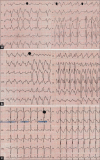Flecainide intoxication in pediatric patients with supraventricular tachycardia
- PMID: 32863668
- PMCID: PMC7437626
- DOI: 10.4103/apc.APC_116_19
Flecainide intoxication in pediatric patients with supraventricular tachycardia
Abstract
Flecainide is a class IC antiarrhythmic indicated for ventricular and supraventricular arrhythmias in pediatric patients without structural heart disease. Flecainide has a narrow therapeutic window and proarrhythmic effect even in therapeutic doses and could lead to a life-threatening intoxication. Dosage errors, accidental intakes, and drug or food interactions, especially with dairy products, can be the cause of the intoxication. We report three consecutive cases of flecainide intoxication in children with supraventricular tachycardia (SVT) in our hospital from 2017 to 2019. Two cases had complete and spontaneous normalization of electrocardiogram (ECG) after flecainide removal. However, admission to the intensive care was required due to a sustained ventricular tachycardia in one case. Flecainide intoxication can be a life-threatening complication in patients with SVT. We believe all children should have close monitoring with serial ECG and plasma levels of flecainide during the 48-72 h after initiation of treatment, and consider hospitalization for patients <1 year of age.
Keywords: Arrhythmia; children; flecainide; intoxication; supraventricular tachycardia.
Copyright: © 2020 Annals of Pediatric Cardiology.
Conflict of interest statement
There are no conflicts of interest.
Figures


Similar articles
-
Efficacy and safety of class IC antiarrhythmic agents for the treatment of coexisting supraventricular and ventricular tachycardia.Am J Cardiol. 1988 Aug 25;62(6):44D-55D. doi: 10.1016/0002-9149(88)90507-3. Am J Cardiol. 1988. PMID: 3136636 Clinical Trial.
-
Proarrhythmic Effects Of Antiarrhythmic Drugs: Case Study Of Flecainide Induced Ventricular Arrhythmias During Treatment Of Atrial Fibrillation.J Atr Fibrillation. 2015 Dec 31;8(4):1091. doi: 10.4022/jafib.1091. eCollection 2015 Dec. J Atr Fibrillation. 2015. PMID: 27957216 Free PMC article.
-
Flecainide as first-line treatment for supraventricular tachycardia in newborns.J Cardiovasc Med (Hagerstown). 2009 May;10(5):372-5. doi: 10.2459/JCM.0b013e328329154d. J Cardiovasc Med (Hagerstown). 2009. PMID: 19300276
-
Inpatient versus outpatient initiation of antiarrhythmic drug therapy for patients with supraventricular tachycardia.Clin Cardiol. 1994 Sep;17(9 Suppl 2):II7-10. doi: 10.1002/clc.4960171405. Clin Cardiol. 1994. PMID: 7882612 Review.
-
[Flecainide and anti-arrhythmia therapy].Minerva Med. 1988 Mar;79(3):229-34. Minerva Med. 1988. PMID: 3129677 Review. Italian.
Cited by
-
Antiarrhythmic Drug Dosing in Children-Review of the Literature.Children (Basel). 2023 May 8;10(5):847. doi: 10.3390/children10050847. Children (Basel). 2023. PMID: 37238395 Free PMC article. Review.
-
Flecainide toxicity: ECG changes associated with supratherapeutic levels in milk-fed infants.BMJ Case Rep. 2023 Feb 2;16(2):e252823. doi: 10.1136/bcr-2022-252823. BMJ Case Rep. 2023. PMID: 36731946 Free PMC article.
-
Drugs associated with a risk of supraventricular tachycardia: analysis using the OpenVigil database.J Int Med Res. 2024 Mar;52(3):3000605241238993. doi: 10.1177/03000605241238077. J Int Med Res. 2024. PMID: 38530149 Free PMC article.
-
Flecainide in clinical practice.Cardiol J. 2023;30(3):473-482. doi: 10.5603/CJ.a2023.0018. Epub 2023 Mar 13. Cardiol J. 2023. PMID: 36908162 Free PMC article. Review.
References
-
- Brugada J, Blom N, Sarquella-Brugada G, Blomstrom-Lundqvist C, Deanfield J, Janousek J, et al. Pharmacological and non-pharmacological therapy for arrhythmias in the pediatric population: EHRA and AEPC-Arrhythmia Working Group joint consensus statement. Europace. 2013;15:1337–82. - PubMed
-
- Köppel C, Oberdisse U, Heinemeyer G. Clinical course and outcome in class IC antiarrhythmic overdose. J Toxicol Clin Toxicol. 1990;28:433–44. - PubMed
-
- Perry JC, Garson A., Jr Flecainide acetate for treatment of tachyarrhythmias in children: Review of world literature on efficacy, safety, and dosing. Am Heart J. 1992;124:1614–21. - PubMed
-
- Close BR, Banks CJ. Pediatric flecainide toxicity from a double dose. Am J Emerg Med. 2012;30:2095e1–2. - PubMed
Publication types
LinkOut - more resources
Full Text Sources
